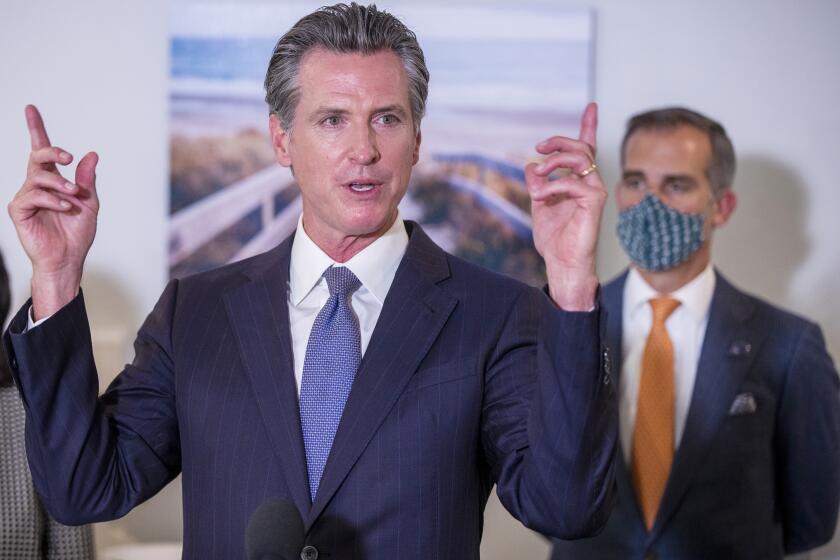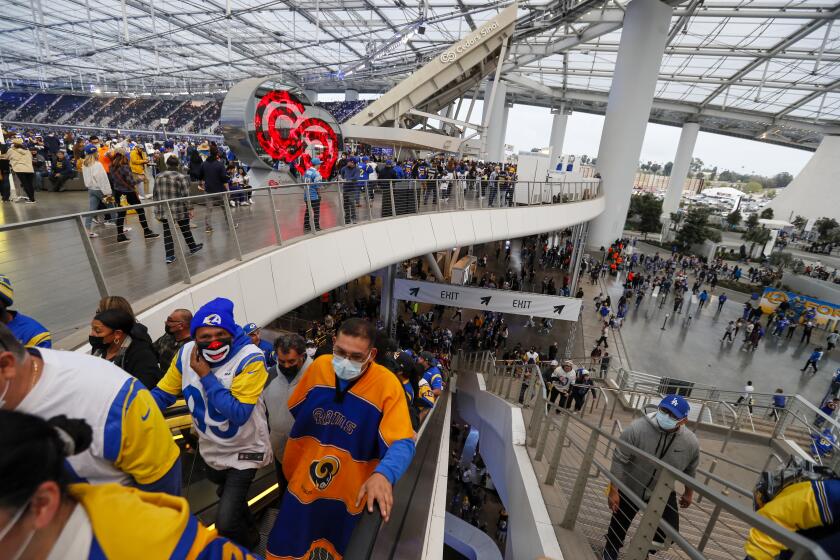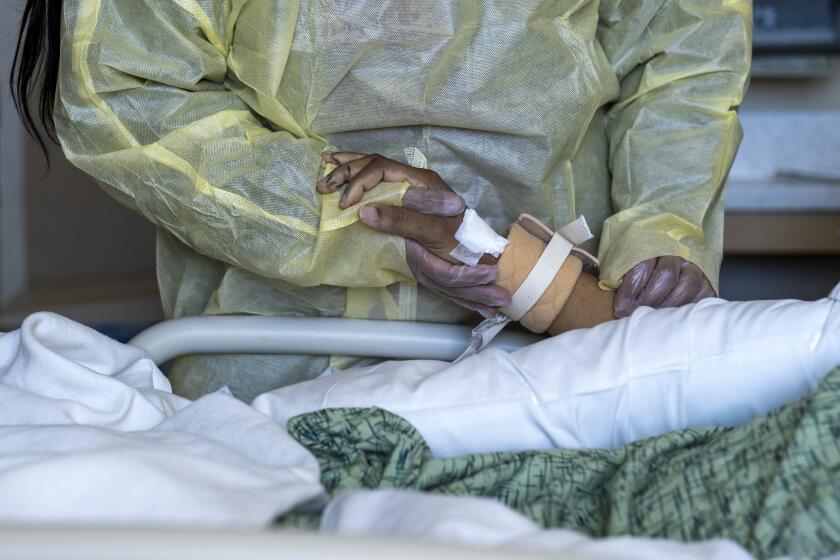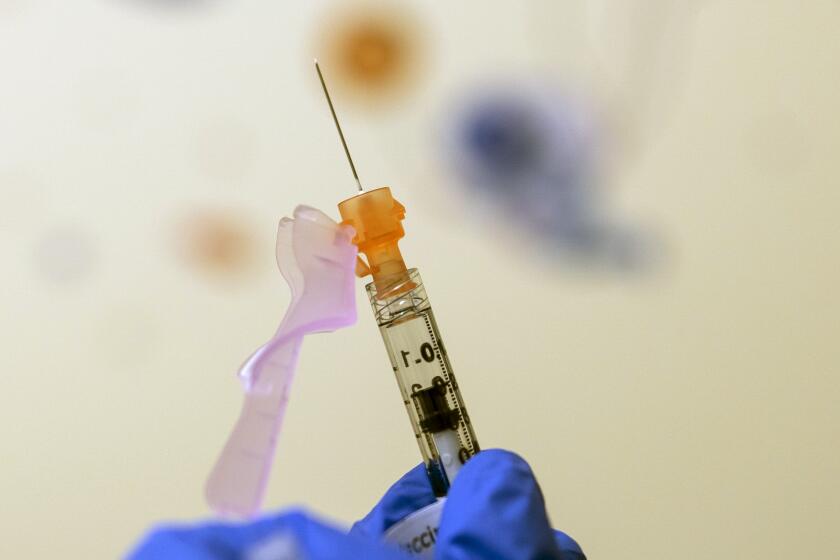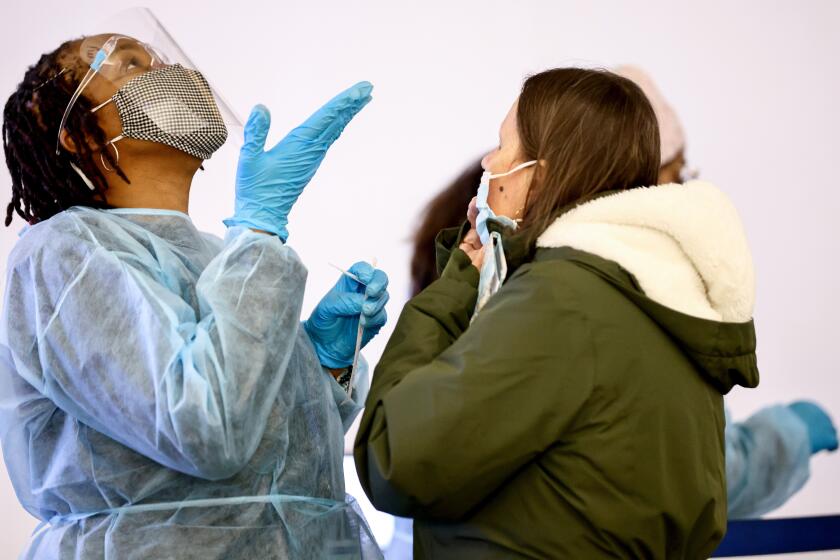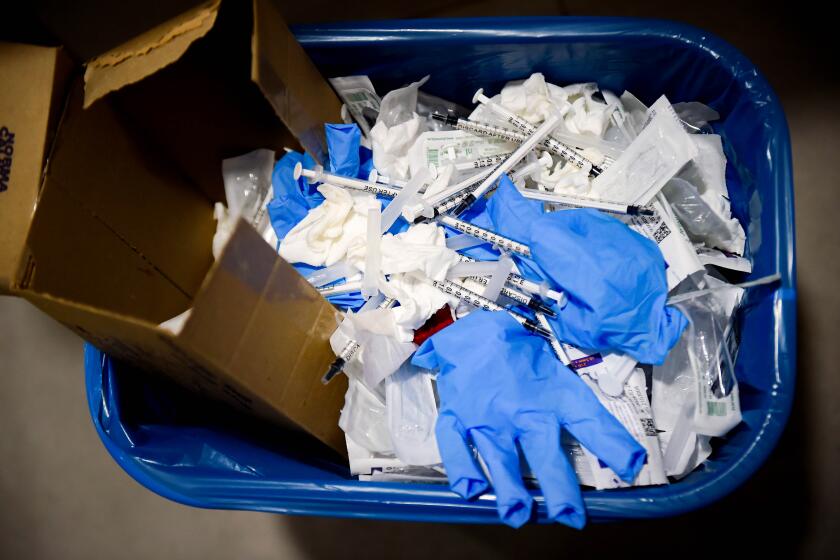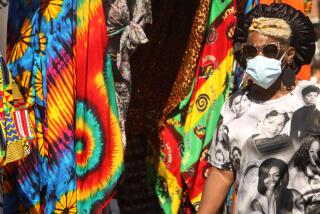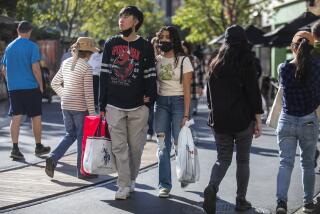L.A. County mask rules under scrutiny after Newsom, Garcetti seen maskless at game

After California Gov. Gavin Newsom and L.A. Mayor Eric Garcetti were seen maskless at Sunday’s Rams game, L.A. County’s mask rules are questioned.
- Share via
The Los Angeles County Department of Public Health is defending its mask-wearing order, which is being criticized after Gov. Gavin Newsom and the mayors of L.A. and San Francisco were photographed without face coverings at Sunday’s NFL playoff game at SoFi Stadium.
The criticism comes as coronavirus case rates are falling but L.A. County recorded 1,347 COVID-19 deaths in January — the highest monthly tally since March, according to a Times analysis. And the pace of daily fatalities continues to climb, reaching an average of 70 deaths a day over the last week, nearly five times the rate heading into Christmas, when the county was averaging 15 deaths a day.
L.A. County Supervisor Kathryn Barger said in a statement Monday that she believes people should be allowed to choose whether to wear a mask. She referred to the observation that many fans at the Rams’ NFC championship game against the San Francisco 49ers in Inglewood on Sunday were not masked, despite L.A. County’s order that people must be at large outdoor events.
“I strongly believe individuals should be allowed to make an informed choice about whether to mask up or not,” Barger said in her statement. “I hope state and local health leaders take this into consideration and reevaluate indoor and school masking mandates now.
“Let’s do away with blanket COVID-19 masking policies — they don’t make a difference when they’re not consistently followed or enforced,” she added. “We need to trust the public to make the best personal decisions for themselves based on their unique risks and circumstances.”
The group was attending the game that saw the Los Angeles Rams defeat the San Francisco 49ers to advance to the Super Bowl.
L.A. County Public Health Director Barbara Ferrer, however, said the fact that many fans were not wearing a mask at Sunday’s game was not a good reason to end the local mask order, which requires face coverings to be worn in indoor public settings and outdoor “mega-events” involving 5,000 or more people.
“Noncompliance with a critical safety measure is not a good reason for ending the requirement,” Ferrer said in a statement. “That would be like eliminating speed limits because so many drivers ignore them and feel that they can assess for themselves the safe speed for their travel.
“At some point soon, transmission will be significantly lower, and we will not need to wear our masks everywhere; unfortunately, we aren’t there yet,” she added. “And in order to get there as quickly as possible, we should all make our best efforts to layer in sensible protections that keep us and those around us safe.”
Besides L.A. County’s mask order, California requires mask wearing in indoor public spaces under an order that is set to expire Feb. 15. County rules cannot be less restrictive than the state’s.
Face masks will be given to Super Bowl spectators at the Inglewood stadium for the game, which is a little more than two weeks away.
Federal, state and many local health officials in California have defended mask orders as essential at a time of exceptionally high coronavirus case rates and crowded conditions in hospitals.
L.A. County is now averaging about 21,000 new coronavirus cases a day, according to a Times analysis of state data made available Tuesday. While that’s less than half of the Omicron variant peak of 44,000 new cases a day, it’s still above the peak of last winter’s devastating surge, which topped out at 16,000 new cases a day.
The latest case numbers equal about 1,500 cases a week for every 100,000 residents. The U.S. Centers for Disease Control and Prevention recommends that masks be worn in indoor public settings when the rate is 50 or more cases a week for every 100,000 residents.
L.A. County last fell below that threshold last spring, but that ended when the highly contagious Delta variant began rapidly spreading over the summer.
This is the latest coronavirus wave where, compared to Southern California, the Bay Area has fared relatively better, and local officials this time credit high rates of vaccination and booster shots.
Reaching that goal is one of several criteria the county Department of Public Health has outlined to end the local mask order for indoor public settings. The other criteria include getting 80% of residents age 12 and older fully vaccinated; getting the number of coronavirus-positive patients in hospitals at fewer than 600 for three straight weeks; and no reports of significantly circulating variants of concern that could threaten vaccine efficacy.
About 78% of L.A. County’s residents 12 and older are fully vaccinated.
Vaccination rates are far lower in younger children in L.A. County, prompting officials to issue an advisory Friday to local healthcare providers urging them to contact parents and strongly recommend children get vaccinated. In L.A. County, only 32% of children in this age group have received at least one shot; by contrast, in San Francisco, 73% of them have gotten one.
Health officials are concerned that low vaccination rates are connected with troubling rises in hospitalization rates among children. Coronavirus-positive hospitalization rates of children in this age group have risen from two per week in mid-November to 23 per week in mid-January.
The company’s application was expected to be submitted as soon as Tuesday.
High uptake of booster shots is generally occurring in counties with high rates of vaccination, as well as adherence to mask orders. A Times analysis found that San Francisco has one of the highest booster rates and lowest cumulative death rates in California, while Southern California and the San Joaquin Valley have higher death rates and lower booster rates.
A study published Tuesday in the CDC’s Morbidity and Mortality Weekly Report further underscores the vaccines’ potent protective power.
Between Nov. 28 and Dec. 11, shortly before the Omicron variant became dominant, L.A. County noted that the case and hospitalization rates among unvaccinated people were 3.8 times higher and 12.9 times higher, respectively, than those who had been fully vaccinated but not boosted.
The difference was starker still when comparing those who were boosted with those who had yet to roll up their sleeves. Over this period, the case rate for unvaccinated individuals was 12.3 times higher than among those who had been vaccinated and boosted. The hospitalization rate for unvaccinated people was 83 times higher.
The emergence of Omicron — a far-more-transmissible version of the coronavirus — shrank the margins, but sizable gaps remained.
Since the Omicron coronavirus variant was discovered, officials have said the best defense is vaccinations and getting booster shots.
Between Dec. 26 and Jan. 8, when Omicron was rampant, the infection rate for unvaccinated people was twice as high as those who had been vaccinated and 3.6 times higher than those who had been boosted. In hospitalizations, the rate for unvaccinated people was 5.3 times higher than their vaccinated counterparts and 23 times higher than those who had been boosted.
The findings illustrate what health officials have long maintained: Getting vaccinated, and especially boosted, helps stave off infection and makes it far less likely that someone will fall seriously ill.
“Vaccines do remain our best tool for preventing COVID-19,” Ferrer said during a briefing last week. “Getting as many people vaccinated as soon as possible can help us sustain the declines we’re seeing and limit opportunities in the future for new variants to arise.”
Authorities are still warning that hospitals throughout Southern California remain under strain, even as the number of coronavirus-positive patients has begun to decline. As of Monday, there were 3,710 coronavirus-positive patients in L.A. County’s hospitals, a drop of 23% from the apparent Omicron peak of 4,814 on Jan. 19.
Overuse of gloves and ‘moon suits’ and the use of billions of masks and vaccination syringes have caused a glut of COVID-19 waste worldwide.
The number of coronavirus-positive intensive care unit patients — 719 — is down about 9% from the Omicron-era peak of 794, recorded on Jan. 23.
Some public health experts cautioned against eliminating mask requirements while case rates remain high.
“With infections still high, indoor mask mandates make sense,” tweeted Dr. Ashish Jha, dean of the Brown University School of Public Health. “During big surges, as hospitals overflow, individual action isn’t enough. Collective action is needed, which often means mandates.”
But once coronavirus case rates fall further — and the Omicron storm becomes a drizzle — mandates will become less necessary, Jha added.
The “key is to communicate: During periods of low infections, restrictions come off. During potential future surges, public health measures may need to temporarily return,” Jha wrote.
John Barry, author of “The Great Influenza: The Story of the Deadliest Pandemic in History,” warned in an op-ed this week about abandoning public health measures prematurely.
Many histories say the great 1918 flu pandemic ended in the summer of 1919, but it actually lasted through 1920, with a final, fourth wave even deadlier in some U.S. cities than the devastating surge of the fall of 1918, Barry said. But virtually no U.S. city responded with control measures in the pandemic’s third and final year because officials were weary of the fight.
“Newspapers were filled with frightening news about the virus, but no one cared. People at the time ignored this fourth wave; so did historians,” Barry wrote. “The virus mutated into ordinary seasonal influenza in 1921, but the world had moved on well before. We should not repeat that mistake.”
More to Read
Sign up for Essential California
The most important California stories and recommendations in your inbox every morning.
You may occasionally receive promotional content from the Los Angeles Times.
